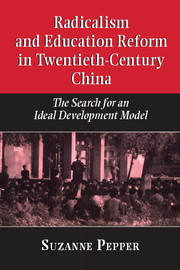Book contents
- Frontmatter
- Contents
- Acknowledgments
- 1 Educational development and the Chinese experience
- Part I The republican era: origins of radical education reform
- Part II Learning from the Soviet Union
- Part III Cultural revolution and radical education reform
- 11 On Stalin, Khrushchev, and the origins of cultural revolution
- 12 The great leap in education
- 13 A system divided: walking on two legs into the 1960s
- 14 Education reform as the catalyst for cultural revolution and class struggle: the 1966–1968 mobilization phase
- 15 Education reform as the culmination of class struggle: the professional educator's perspective
- 16 Education reform as the culmination of class struggle: the critical ideals triumphant at last
- 17 The Cultural Revolution negated
- 18 The mixed triumph of regularity
- 19 Chinese radicalism and education development
- Appendix: the Hong Kong interviews
- Select bibliography
- Index
12 - The great leap in education
Published online by Cambridge University Press: 04 August 2010
- Frontmatter
- Contents
- Acknowledgments
- 1 Educational development and the Chinese experience
- Part I The republican era: origins of radical education reform
- Part II Learning from the Soviet Union
- Part III Cultural revolution and radical education reform
- 11 On Stalin, Khrushchev, and the origins of cultural revolution
- 12 The great leap in education
- 13 A system divided: walking on two legs into the 1960s
- 14 Education reform as the catalyst for cultural revolution and class struggle: the 1966–1968 mobilization phase
- 15 Education reform as the culmination of class struggle: the professional educator's perspective
- 16 Education reform as the culmination of class struggle: the critical ideals triumphant at last
- 17 The Cultural Revolution negated
- 18 The mixed triumph of regularity
- 19 Chinese radicalism and education development
- Appendix: the Hong Kong interviews
- Select bibliography
- Index
Summary
The claims for 1958 were extravagant, befitting the high tide of a national mass movement on all fronts. Production targets for industry and agriculture began leaping and bounding. “As I see now, there has never been such an upsurge of enthusiasm and initiative among the masses of the people on the production front,” declared Mao in his February 1958 guidelines for the Great Leap Forward.
In the countryside, agricultural producers cooperatives merged to form much larger communes. Instead of hundreds of people working together and jointly sharing the income earned, now thousands did so. Cooking pots went into local smelters, bolstering the great leap in iron and steel production. Commune mess halls were promoted as successors to the family kitchen while nurseries and “happiness homes” cared for young and old. Freed from household chores, women were mobilized to join the work force outside the home in numbers greater than ever before, and they were needed as never before. China's enormous population was transformed overnight from a liability into an asset, much as the mini-leap of 1956 had turned too many school graduates into too few. Now all hands were needed for massive public works, farmland capital construction, dam building, canal digging, coal mining, smelting, and all the projects necessary to create communist economies of scale upon a base of only just collectivized and not yet mechanized peasant producers.
In north China, preparations commenced to restore Pingyuan Province, created originally from the communist border regions in the 1940s, at the juncture of Henan, Hebei, and Shandong.
- Type
- Chapter
- Information
- Radicalism and Education Reform in 20th-Century ChinaThe Search for an Ideal Development Model, pp. 278 - 301Publisher: Cambridge University PressPrint publication year: 1996



